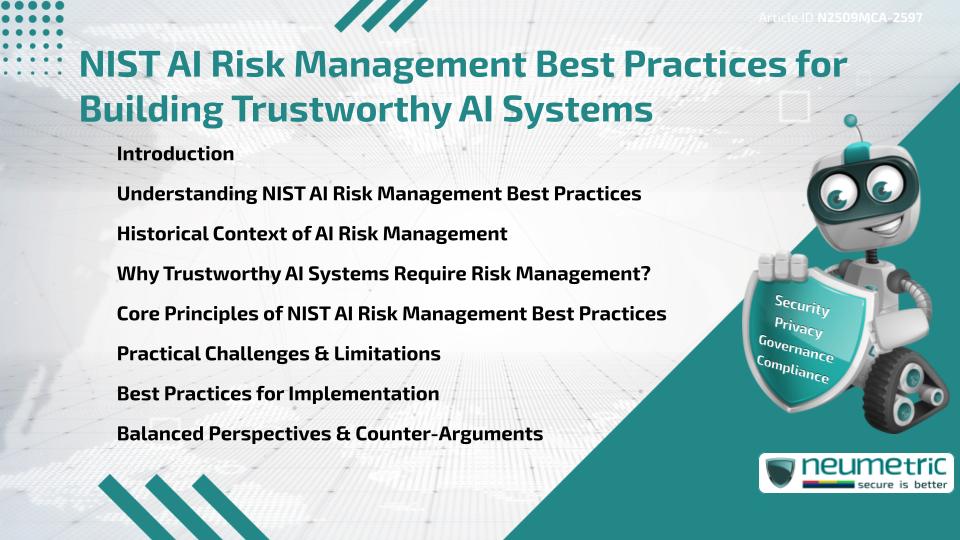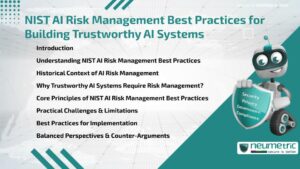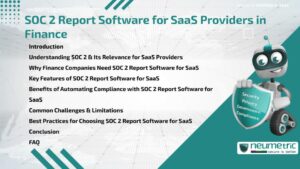Table of Contents
ToggleIntroduction
NIST AI Risk Management Best Practices provide Organisations with structured guidance to build trustworthy AI Systems. These practices focus on identifying, assessing & mitigating Risks that emerge from AI adoption, ranging from fairness & accountability to Privacy & safety. By following these practices, Organisations improve resilience, foster public trust & align AI Systems with legal & Ethical Standards. This article explores the historical roots, principles, challenges & balanced viewpoints on adopting NIST AI Risk Management Best Practices.
Understanding NIST AI Risk Management Best Practices
The National Institute of Standards & Technology NIST developed AI Risk Management Best Practices to help Organisations navigate the complexity of AI Governance. These Best Practices highlight the need to balance innovation with safeguards. They emphasize fairness, transparency, accountability & robustness. The Framework helps reduce potential harms caused by biased algorithms, data misuse or security Vulnerabilities.
Historical Context of AI Risk Management
Risk Management in technology is not new. For decades, frameworks like ISO 31000 & Cybersecurity standards guided Organisations in managing Risk. With the advent of AI, traditional methods proved insufficient. Complexities such as algorithmic bias, explainability challenges & unforeseen social impacts demanded new approaches. In response, NIST designed AI Risk Management Best Practices to extend established Governance models into the realm of intelligent systems.
Why Trustworthy AI Systems Require Risk Management?
Trust is at the core of AI adoption. If AI Systems are seen as unreliable, opaque or unfair, users may reject them. NIST AI Risk Management Best Practices address these concerns by enforcing safeguards against bias, ensuring Data Integrity & mandating accountability. For example, in Healthcare, AI-driven diagnostics must meet safety & fairness standards to gain regulatory approval & public acceptance. Without structured Risk Management, even innovative AI Systems Risk being perceived as harmful.
Core Principles of NIST AI Risk Management Best Practices
The NIST Framework identifies key areas of focus:
- Transparency: Clear documentation of AI Models & decision-making processes.
- Accountability: Defined roles & responsibilities for oversight.
- Fairness: Mitigating algorithmic biases to ensure equitable outcomes.
- Robustness: Ensuring systems perform reliably under different conditions.
- Privacy: Protecting Personal Data in compliance with legal standards.
- Security: Safeguarding against adversarial attacks & system manipulation.
These principles serve as cornerstones for Organisations aiming to create responsible AI ecosystems.
Practical Challenges & Limitations
Despite their benefits, implementing NIST AI Risk Management Best Practices is challenging. Some Organisations face resource limitations, making it difficult to adopt complex Governance models. AI developers may view compliance as slowing innovation. Furthermore, the global nature of AI complicates enforcement since standards differ across jurisdictions. Over-reliance on technical controls without considering social or ethical dimensions also weakens effectiveness.
Best Practices for Implementation
Organisations can adopt NIST AI Risk Management Best Practices by:
- Conducting thorough Risk Assessments at each stage of AI Development.
- Embedding fairness & transparency into design processes.
- Creating cross-disciplinary Governance teams.
- Training staff to understand & manage AI-related Risks.
- Performing Continuous Monitoring & independent audits.
Practical implementation requires not only technical tools but also cultural changes that prioritise ethical considerations.
Balanced Perspectives & Counter-Arguments
Critics argue that excessive focus on compliance may hinder AI innovation & increase costs. Small Businesses, in particular, may find NIST AI Risk Management Best Practices burdensome. Others question whether frameworks can keep up with the rapid pace of AI advancements. While these concerns are valid, they overlook the fact that unchecked AI Risks may lead to reputational harm, legal penalties & loss of trust. A balanced approach ensures that Risk Management safeguards innovation rather than obstructing it.
Takeaways
NIST AI Risk Management Best Practices provide a structured pathway for Organisations to build trustworthy AI Systems. While challenges exist, these practices strengthen accountability, reduce Risk & enhance public trust. Responsible implementation allows innovation to thrive while maintaining ethical & legal compliance.
FAQ
What are NIST AI Risk Management Best Practices?
They are guidelines developed by NIST to help Organisations manage Risks associated with AI Systems, ensuring fairness, accountability & security.
Why are NIST AI Risk Management Best Practices important?
They help Organisations build trustworthy AI Systems by identifying & mitigating Risks such as bias, Privacy breaches & security Vulnerabilities.
How do these Best Practices differ from traditional Risk Management?
Traditional Risk Management focuses on Financial or operational Risks, whereas NIST AI Risk Management Best Practices address unique AI challenges such as algorithmic bias & explainability.
Can Small Businesses adopt NIST AI Risk Management Best Practices?
Yes, though they may need to adapt the practices to their scale by focusing on critical Risks & leveraging cloud-based compliance tools.
Do NIST AI Risk Management Best Practices align with global AI Regulations?
They align broadly with international principles but may require adaptation to meet region-specific requirements such as the EU AI Act.
What challenges arise in implementing these Best Practices?
Challenges include resource constraints, resistance from developers, global regulatory differences & balancing innovation with oversight.
Who benefits from adopting NIST AI Risk Management Best Practices?
Stakeholders including businesses, regulators, consumers & society at large benefit from safer, more accountable & trustworthy AI Systems.
Need help for Security, Privacy, Governance & VAPT?
Neumetric provides organisations the necessary help to achieve their Cybersecurity, Compliance, Governance, Privacy, Certifications & Pentesting needs.
Organisations & Businesses, specifically those which provide SaaS & AI Solutions in the Fintech, BFSI & other regulated sectors, usually need a Cybersecurity Partner for meeting & maintaining the ongoing Security & Privacy needs & requirements of their Enterprise Clients & Privacy conscious Customers.
SOC 2, ISO 27001, ISO 42001, NIST, HIPAA, HECVAT, EU GDPR are some of the Frameworks that are served by Fusion – a SaaS, multimodular, multitenant, centralised, automated, Cybersecurity & Compliance Management system.
Neumetric also provides Expert Services for technical security which covers VAPT for Web Applications, APIs, iOS & Android Mobile Apps, Security Testing for AWS & other Cloud Environments & Cloud Infrastructure & other similar scopes.
Reach out to us by Email or filling out the Contact Form…





